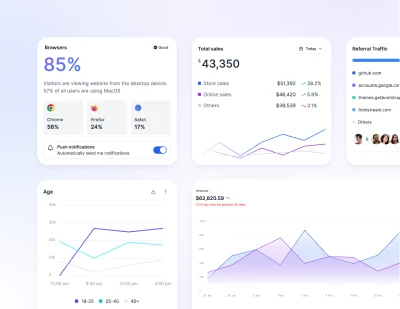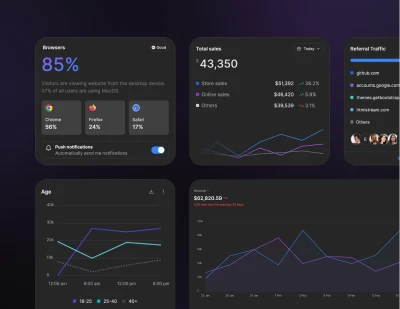- Overview
- About Preline UI
Overview
About Preline UI
Preline UI is an open-source Tailwind CSS components library for any needs. Comes with UI examples & blocks, templates, plugins, Figma design system and more.
Introduction
Preline UI is an open-source Tailwind CSS component library that provides a huge collection of prebuilt UI components, example blocks & pages, headless plugins, templates, and even a Figma Design System.
Its goal is to help developers quickly build websites and web apps by offering ready-made Tailwind-styled components (buttons, forms, navbars, modals, etc.) that can be copied and customized easily. Whether you're prototyping a new product, building an enterprise dashboard, or launching a landing page, Preline UI offers a scalable design foundation that's easy to customize and extend.
Preline UI helps teams build clean, responsive interfaces faster, without sacrificing design quality or accessibility.
Importantly, Preline's approach aligns with Tailwind's utility-first philosophy. Components are built entirely with standard Tailwind classes (without any heavy customization requirement), which means developers don't need to learn any new API or naming convention to use Preline.
Preline's components work in any Tailwind project with minimal setup. From a first-principles perspective, Preline is simply sharing the “blueprints” for UI elements built with the same basic building blocks developers are already using. Developers can drop a Preline snippet into their code and it will work with their existing Tailwind setup, as long as Tailwind CSS is initialized. This is valuable because it adds convenience without abstracting away control. Developers can still tweak the utility classes if needed for custom styling, which is essentially the same workflow as coding UI from scratch, just starting from a more complete baseline.
Why use Preline UI?
The core need that Preline UI addresses is the demand for speed and efficiency in UI development without sacrificing flexibility. As Tailwind CSS adoption grows, many developers and teams find themselves writing similar UI components repeatedly or spending time on basic UI scaffolding.
Component libraries solve this by providing pre-designed, consistent building blocks. Preline UI exists to save developers time and effort: it allows rapid assembly of interfaces by copying ready-made Tailwind-based components, instead of hand-coding every button, form, or layout from scratch. This not only accelerates development but also ensures a level of design consistency and responsiveness out-of-the-box.
The market needs Preline UI for a few specific reasons:
- Breadth of content: Preline offers far more prebuilt components and example pages than most free libraries. This is crucial for teams that need a wide variety of elements (dashboards, landing pages, forms, modals, etc.) and even complete template pages. Instead of piecing together bits from multiple smaller libraries, a developer can rely on Preline as a one-stop resource for most UI needs. If a project requires dozens of different component types, using a comprehensive kit like Preline is a significant time saver. In addition, optionally Preline Pro provides huge collection of Examples and Templates to speed up development even more.
- Rapid prototyping and MVPs: Startups and indie developers often need to build minimum viable products or prototypes under tight deadlines and budgets. Preline UI, being free and extensive, is an attractive solution to assemble a professional-looking UI quickly. It helps non-designers implement polished interfaces without hiring a designer or front-end expert. This reduces cost and time-to-market for new products.
- Design-development workflow: Preline uniquely includes a large Figma design system matching the components. This means designers can prototype or design in Figma using Preline's components, and developers can directly implement those using the equivalent Tailwind code from Preline. That alignment of design and code speeds up the workflow and ensures high fidelity between design mockups and the final product. Teams that have both designers and developers collaborating benefit from this shared system, a feature not all competitors provide at the same scale. Please note that Preline Figma Design System is mainly covers components, not Examples & Pages as it mainly focuses on providing a consistent Design System not Figma first product.
- Consistency and best practices: For less experienced developers, crafting accessible and responsive UI components can be challenging. Preline's components come with accessibility considerations and responsive design baked in (e.g. support for dark mode variants by default, proper ARIA roles in interactive components, etc.). This helps raise the baseline quality of projects. Instead of reinventing the wheel (and possibly making usability mistakes), developers get battle-tested patterns. In essence, Preline acts as a repository of UI best practices implemented in Tailwind projects.
- Avoiding lock-in and heavy frameworks: Compared to full UI frameworks (like Bootstrap, or even React component libraries), Preline's utility-class approach means it doesn't lock you into a rigid style or framework. You can cherry-pick only what you need. If you only need one component, you can use it without pulling in a large CSS bundle or JavaScript overhead. Every single JavaScript plugin can be used standalone without loading the entire library if needed.
In summary, Preline UI addresses a fundamental problem in modern web development: how to build beautiful, responsive, and accessible UIs faster and with less effort. It does so in a way that remains realistic and pragmatic, by leveraging the ubiquitous Tailwind CSS utilities and not introducing unnecessary complexity. This makes Preline valuable to a broad range of users: from solo developers hacking together a concept, to design/development teams seeking consistency, to enterprises looking to enforce a standard design system across multiple projects.
What's in the box?
Here are the key advantages that Preline UI offers, broken down to their atomic benefits:
- Extensive Components: Preline UI contains hundreds of components (640+ and growing), covering almost any UI element a web project might need. This is one of the largest collections available among any Tailwind libraries in the market.
- Headless Tailwind CSS Plugins: Preline UI includes in-house built 25+ headless fully unstyled Tailwind JavaScript plugins.
- Massive Set of Examples: Preline provides 220+ examples and starter pages sections for free. These examples illustrate how to compose individual components into ready-to-use pages (dashboards, landing pages, auth pages, etc.).
- Premium grade Templates: Preline UI includes for completely free 5 templates and counting for dashboards, landing pages and more from our Preline Pro collection for free as getting started point while Preline Pro extends it with more pages and examples.
- Figma Design System: Preline UI includes a comprehensive Figma Design System that matches the components with over 30k+ downloads and 5 starts on various platforms.
- Accessibility: Preline UI is built with accessibility in mind. All components are designed to be accessible by default, with proper ARIA roles, attributes, keyboard support, and more.
- Built-in Dark Mode Support: All components are built with dark mode compatibility out-of-the-box.
- JSX Support: Preline UI includes JSX copy code support for all components optionally to use in React projects. Please note that Preline UI does not include built-in React components, only JSX code snippets.
Open Source & Community
Preline UI is actively maintained and updated with new components, examples, and templates. You may see the changelog history and Github activity. It has nearly 6k Github starts and hundreds closed issues with active discussions and community support.
Join the Preline community on GitHub to suggest features, report issues, or contribute code: github.com/htmlstreamofficial/preline

